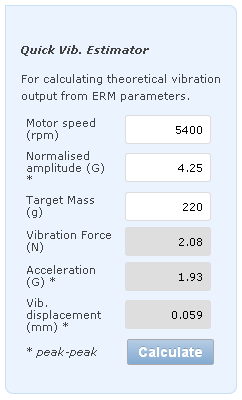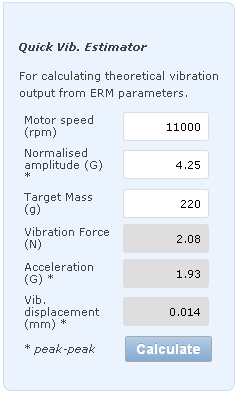Vibration Frequency vs Displacement
Is there an ideal frequency for vibration alerting or haptic feedback? Different nerves in our skin are more sensitive to different frequencies, but generating vibrations at these frequencies may not be quite so simple.
As the vibration frequency increases, the duration of time for the force to be applied in one direction is reduced. Due to the cyclical nature of vibration actuators (both ERMs and LRAs) high-frequency vibrations only have a short period of time to displace the motor before it is displaced in the opposite direction.
This means the peak-to-peak displacement is greatly reduced. We can test this with the Quick Vib Estimator in this link (currently depreciated!). Follow this example using the Uni Vibe™ 312-201:
- Set Motor Speed to Rated Speed of 312-201 = 5,400 RPM
- Set Normalised Amplitude to Typical Normalised Amplitude of 312-201 = 4.25 G
- Set Target Mass to a reasonable mass of a handheld product, say 220 g


We can see the resulting Vibration Force (2.08 N), Acceleration (1.93 G), and Vib Displacement (0.059 mm) when we click ‘calculate’. Remember the vibration frequency is equal to the motor speed divided by 60, so our 312-201 is vibrating about 90 Hz.
Now let’s consider that some of the human mechanoreceptors are more responsive at 250 Hz. Let’s try a faster motor to get closer to this range, but one that has the same vibration amplitude so we can directly compare the difference in displacement.
The 312-105 looks like a good fit, it’s rated at 11,000 RPM (183 Hz) and 4.25 G.
Back to our Quick Vib Estimator, change the Motor Speed to 11,000 RPM (183 Hz) and of course, leave the Typical Normalised Amplitude at 4.25 G. When we click calculate notice that the Vibration Force and Acceleration do not change, but the Vibration Displacement is now only 0.014 mm.
What does this mean in terms of haptics? Should you aim for a larger displacement and sacrifice the ‘ideal’ frequency range? Unfortunately, this is not an area that (to our knowledge) has been studied, in fact, much of the frequency response research overlooks this practical limitation.
As lower frequency vibrations are less susceptible to damping (because they create bigger displacement) if there is a chance of soft materials, like protective gloves, between the product and user we recommend the lower frequencies. If you’ve experienced positive or negative effects either way, why not let us know.

Get in touch
Speak to a member of our team.
Motor catalogue
Looking for our products?
Reliable, cost-effective miniature mechanisms and motors that meet your application demands.
Discover more
Resources and guides
Discover our product application notes, design guides, news and case studies.
Case studies
Explore our collection of case studies, examples of our products in a range of applications.
Precision Microdrives
Whether you need a motor component, or a fully validated and tested complex mechanism – we’re here to help. Find out more about our company.